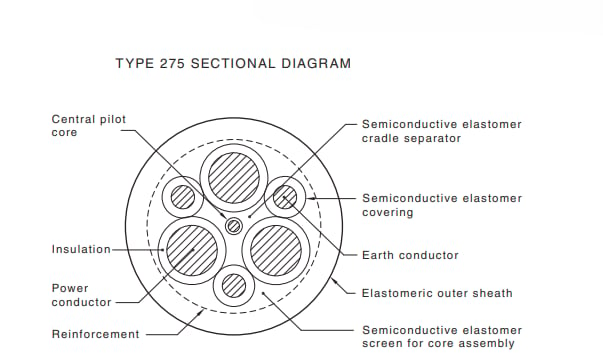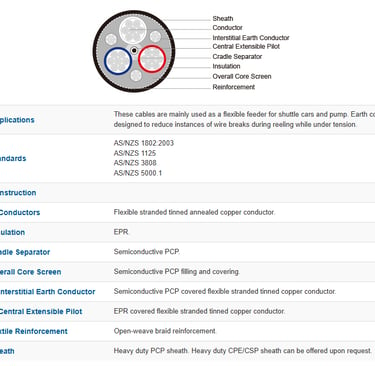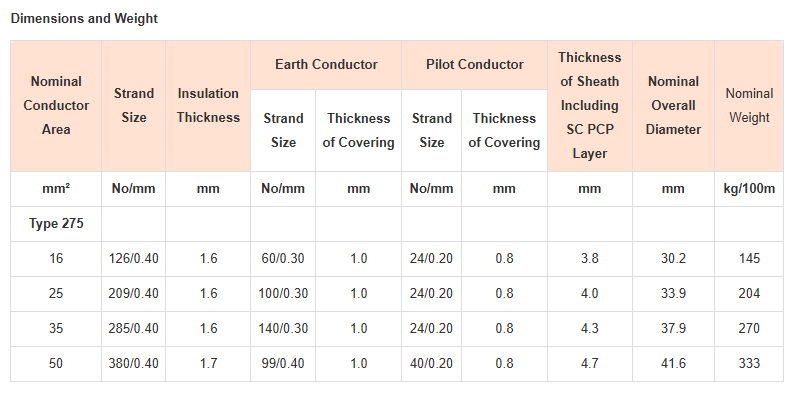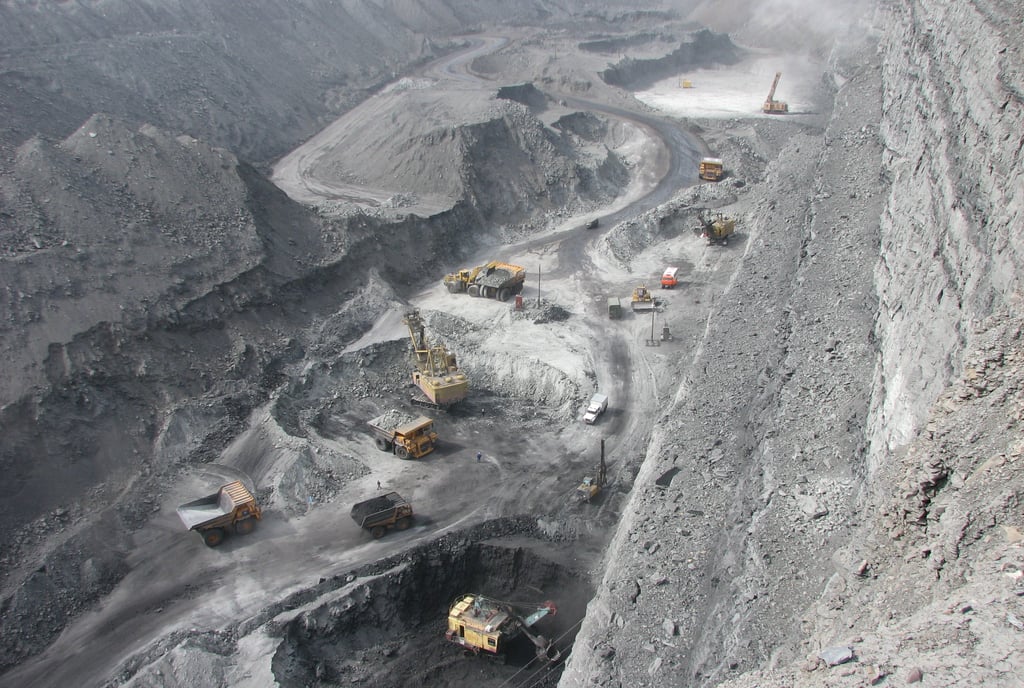Anhui Feichun Special Cable Co.,Ltd Li.wang@feichuncables.com
Why is AS/NZS Type 275 Mining Cable the Ultimate Solution for Dynamic Underground Operations?
Discover AS/NZS Type 275 mining cable specifications, applications, and benefits. Learn how this flexible reeling cable compares to other mining cable types and why it's essential for underground operations.
Li.wang@Feichun Cable
7/24/202512 min read


Introduction
Underground mining operations demand exceptional reliability and performance from electrical infrastructure, particularly when it comes to power transmission cables. The harsh conditions of subterranean environments—including extreme temperature fluctuations, mechanical stress, chemical exposure, and constant movement—require specialized cable solutions that can withstand these challenges while maintaining optimal electrical performance. Among the various mining cable standards established by Standards Australia and Standards New Zealand, the AS/NZS Type 275 mining cable stands out as a premier solution specifically engineered for dynamic applications in underground mining operations.
The significance of selecting the appropriate mining cable cannot be overstated. A cable failure in an underground mining environment can result in catastrophic consequences, including production downtime, safety hazards, and substantial financial losses. The AS/NZS Type 275 cable represents decades of engineering expertise and real-world testing, designed to meet the stringent requirements of modern mining operations while providing the flexibility and durability necessary for continuous reeling and trailing applications.
This comprehensive examination will explore the technical specifications, unique characteristics, and practical applications of AS/NZS Type 275 mining cable, providing mining professionals with the essential knowledge needed to make informed decisions about their electrical infrastructure requirements.
AS/NZS Type 275 Mining Cable Overview
The AS/NZS Type 275 mining cable is a specialized electrical cable designed according to Australian and New Zealand standards for use in underground mining environments. This cable is specifically engineered for dynamic applications where flexibility, durability, and electrical performance are paramount. Operating at voltage levels of 1.1/1.1 kV (1100V line-to-line and 1100V line-to-earth), the Type 275 cable serves as the backbone for power distribution systems in mobile mining equipment and reeling applications.
Technical Specifications and Construction
The construction of AS/NZS Type 275 cable incorporates several critical design elements that distinguish it from conventional industrial cables. The cable features a stranded copper conductor configuration that provides excellent conductivity while maintaining the flexibility required for dynamic applications. The insulation system typically consists of cross-linked polyethylene (XLPE) or ethylene propylene rubber (EPR), materials specifically chosen for their superior electrical properties and resistance to the harsh chemical and physical conditions encountered in mining environments.
One of the most distinctive features of Type 275 cable is its enhanced flexibility characteristics. The cable incorporates a specially designed conductor stranding pattern and optimized insulation thickness that allows for tight bending radii without compromising electrical integrity. This flexibility is crucial for reeling applications where the cable must repeatedly wind and unwind around cable reels while maintaining consistent electrical performance.
The outer sheath of Type 275 cable is constructed from materials specifically formulated to resist abrasion, chemicals, and environmental stresses common in underground mining operations. This protective layer serves as the first line of defense against mechanical damage, moisture ingress, and chemical degradation that could compromise the cable's electrical performance or safety characteristics.
Voltage Rating and Electrical Characteristics
The 1.1/1.1 kV voltage rating of AS/NZS Type 275 cable positions it perfectly for medium-voltage applications in underground mining operations. This voltage level provides sufficient power transmission capability for most mobile mining equipment while maintaining manageable insulation requirements that preserve the cable's flexibility characteristics. The cable's electrical design incorporates appropriate conductor sizing and insulation thickness to ensure reliable operation under the demanding conditions typical of mining environments.
The impedance characteristics of Type 275 cable are carefully controlled during manufacturing to ensure consistent electrical performance across different installation configurations. This attention to electrical uniformity is particularly important in mining applications where cable lengths may vary significantly depending on the specific operational requirements and equipment positioning.
Environmental Resistance Properties
Underground mining environments present unique challenges that require specialized cable solutions. AS/NZS Type 275 cable incorporates several design features specifically intended to address these environmental challenges. The cable demonstrates excellent resistance to moisture, a critical consideration given the high humidity and water exposure common in underground mining operations.
Chemical resistance is another crucial characteristic of Type 275 cable. Underground mining operations often involve exposure to various chemicals, including acids, bases, and organic solvents used in mineral processing and equipment maintenance. The cable's construction materials are selected and formulated to resist degradation when exposed to these chemicals, ensuring long-term reliability and safety.
Temperature performance is equally important, as underground mining environments can experience significant temperature variations. Type 275 cable is designed to operate reliably across a wide temperature range, maintaining its electrical and mechanical properties under both high-temperature conditions that may occur near heat-generating equipment and low-temperature conditions that may be encountered in certain underground environments.
Brief Comparison with Other AS/NZS Mining Cable Models
Understanding the relationship between AS/NZS Type 275 cable and other mining cable models within the AS/NZS standard family is essential for selecting the most appropriate cable for specific applications. Each cable type within the AS/NZS mining cable series is engineered to address particular operational requirements and voltage levels, with distinct characteristics that make them suitable for different mining applications.
Type 209 (1.1 to 11 kV): Higher Voltage Applications
AS/NZS Type 209 mining cable operates across a significantly higher voltage range, from 1.1 kV up to 11 kV, making it suitable for primary power distribution applications in large mining operations. Unlike Type 275, which prioritizes flexibility for dynamic applications, Type 209 is designed primarily for stationary installations where higher voltage transmission is required. The cable's construction incorporates thicker insulation and more robust shielding systems to handle the increased electrical stress associated with higher voltages.
The conductor configuration in Type 209 cables is typically designed for maximum current-carrying capacity rather than flexibility. This results in a cable that excels in high-power applications but lacks the dynamic characteristics necessary for reeling and trailing applications. In a practical mining scenario, Type 209 might be used for the main power feed from the surface transformer to underground distribution panels, while Type 275 would handle the flexible connections to mobile equipment from those distribution points.
Type 210 (1.1/1.1 kV): Continuous Miner Applications
AS/NZS Type 210 cable shares the same voltage rating as Type 275 (1.1/1.1 kV) but is specifically designed for continuous mining machines rather than general reeling applications. The construction of Type 210 cable emphasizes durability and resistance to the specific stresses encountered by continuous miners, including constant vibration, abrasion from coal and rock particles, and exposure to mining chemicals.
While both Type 210 and Type 275 operate at the same voltage level, their physical construction differs significantly. Type 210 typically incorporates a more robust outer sheath and enhanced mechanical protection, but sacrifices some flexibility compared to Type 275. This makes Type 210 ideal for continuous miners that operate in relatively fixed positions but less suitable for applications requiring frequent reeling and unreeling.
A notable example of this distinction occurred at a Queensland coal mine where initially Type 210 cable was specified for shuttle car applications. The reduced flexibility of Type 210 resulted in premature failure at the cable reel connection points due to excessive bending stress. Switching to Type 275 cable resolved these issues and significantly extended cable service life.
Type 241 (1.1 to 11 kV): Alternative Continuous Miner Solution
AS/NZS Type 241 cable represents another approach to continuous miner applications, operating across the 1.1 to 11 kV voltage range. Like Type 275, Type 241 incorporates semiconductive screens for improved electrical performance, but differs in core configuration and overall construction philosophy. Type 241 is designed with enhanced screening systems that provide superior electrical performance in high-interference mining environments.
The semiconductive screens in Type 241 cable provide excellent electromagnetic compatibility (EMC) performance, making it particularly suitable for mining operations where sensitive electronic equipment operates in close proximity to power cables. However, this enhanced electrical performance comes at the cost of reduced flexibility compared to Type 275, limiting its application in dynamic reeling scenarios.
Type 440/441 (1.1 to 22 kV): High-Voltage Static Applications
The AS/NZS Type 440 and 441 cables represent the high-voltage end of the mining cable spectrum, designed for applications up to 22 kV. These cables incorporate significantly thicker insulation systems and enhanced shielding configurations to handle the electrical stresses associated with high-voltage operation. The construction philosophy for these cables prioritizes electrical performance and long-term reliability over flexibility.
Type 440/441 cables are typically employed in static installations such as main underground feeders, transformer connections, and primary distribution systems. Their robust construction and high voltage capability make them ideal for applications where maximum power transmission is required, but their reduced flexibility makes them unsuitable for dynamic applications.
In a large iron ore mining operation in Western Australia, Type 441 cable is used for the 22 kV underground primary distribution system, feeding high-voltage transformers positioned throughout the mine. From these transformers, Type 275 cable provides the flexible connections needed for mobile equipment operations, demonstrating how different cable types work together in a comprehensive mining electrical system.
Key Distinction: Flexibility for Dynamic Operations
The fundamental distinction that sets AS/NZS Type 275 apart from other mining cable models is its optimization for dynamic reeling and trailing applications. While other cable types may offer higher voltage capabilities, enhanced chemical resistance, or superior mechanical protection, Type 275 achieves the optimal balance of electrical performance, environmental resistance, and mechanical flexibility required for continuous reeling operations.
This flexibility advantage becomes particularly apparent in applications such as longwall mining systems, where cables must repeatedly wind and unwind around cable reels while maintaining electrical integrity. The specialized conductor stranding and insulation design of Type 275 cable allows it to withstand millions of flexing cycles without degradation, a capability that distinguishes it from more rigid cable designs.
Applications and Benefits
The unique characteristics of AS/NZS Type 275 mining cable make it the preferred solution for a wide range of underground mining applications where flexibility and reliability are paramount. Understanding these applications and their associated benefits provides valuable insight into why Type 275 has become an industry standard for dynamic mining operations.
Longwall Mining Systems
Longwall mining represents one of the most demanding applications for mining cables, requiring continuous reeling and unreeling as the longwall face advances. AS/NZS Type 275 cable excels in this application due to its exceptional flexibility and resistance to fatigue failure. The cable must withstand constant movement while maintaining electrical integrity to power the shearer, armored face conveyor, and hydraulic roof supports that comprise the longwall system.
A prominent example of Type 275 cable success in longwall applications comes from the Grosvenor Mine in Queensland, where the cable's flexibility characteristics enabled reliable power transmission over extended mining campaigns. The cable's ability to maintain electrical performance despite millions of flexing cycles resulted in significant reductions in maintenance downtime and replacement costs compared to less flexible alternatives.
Mobile Equipment Applications
Underground mining operations rely heavily on mobile equipment including shuttle cars, continuous miners, roof bolters, and personnel carriers. These machines require flexible power connections that can accommodate the dynamic movements inherent in their operation. AS/NZS Type 275 cable provides the ideal solution for these applications, offering the flexibility needed for equipment maneuverability while maintaining the electrical performance required for reliable operation.
The cable's resistance to abrasion and chemical exposure proves particularly valuable in mobile equipment applications where cables may come into contact with rough surfaces, mining chemicals, and environmental contaminants. This durability translates directly into reduced maintenance costs and improved equipment availability.
Reeling and Trailing Applications
Cable reeling systems are fundamental to underground mining operations, providing the means to supply power to mobile equipment while accommodating the dynamic nature of mining activities. AS/NZS Type 275 cable is specifically engineered for these reeling applications, with construction characteristics that enable reliable performance through millions of reeling cycles.
The cable's optimized bend radius capabilities allow for compact reel designs that maximize cable storage capacity while minimizing the physical footprint of reeling systems. This characteristic proves particularly valuable in underground environments where space is at a premium and efficient utilization of available area is crucial.
Shuttle Car Systems
Shuttle cars represent a critical application for AS/NZS Type 275 cable, requiring reliable power transmission during the continuous loading and tramming operations that characterize room-and-pillar mining systems. The cable must maintain electrical integrity while accommodating the rapid acceleration, deceleration, and directional changes typical of shuttle car operation.
At the Whitehaven Coal mines in New South Wales, the implementation of Type 275 cable in shuttle car applications resulted in a 40% reduction in cable-related downtime compared to previous cable solutions. The improved reliability translated directly into increased production efficiency and reduced maintenance costs.
Environmental Benefits and Safety Advantages
Beyond its technical performance characteristics, AS/NZS Type 275 cable provides significant environmental and safety benefits that contribute to overall mining operation efficiency. The cable's enhanced durability reduces the frequency of cable replacements, minimizing waste generation and reducing the environmental impact associated with cable disposal and replacement.
From a safety perspective, the reliable electrical performance of Type 275 cable reduces the risk of electrical failures that could create hazardous conditions in underground mining environments. The cable's resistance to moisture and chemical exposure helps prevent insulation degradation that could lead to ground faults or other electrical hazards.
Economic Benefits and Total Cost of Ownership
The economic benefits of AS/NZS Type 275 cable extend beyond its initial purchase price to encompass total cost of ownership considerations. The cable's exceptional durability and reliability result in extended service life, reducing replacement costs and minimizing downtime associated with cable failures.
Maintenance costs are significantly reduced due to the cable's resistance to environmental degradation and mechanical damage. The reduced frequency of cable inspections and repairs translates directly into lower maintenance labor costs and improved equipment availability.
A comprehensive cost analysis conducted at a major Australian coal mining operation demonstrated that while Type 275 cable commanded a premium price compared to standard industrial cables, the total cost of ownership over a five-year period was 35% lower due to reduced replacement and maintenance costs.
FAQ:
What makes AS/NZS Type 275 cable different from standard industrial cables?
A: AS/NZS Type 275 cable is specifically engineered for the demanding conditions of underground mining operations. Unlike standard industrial cables, Type 275 incorporates specialized construction features including enhanced flexibility for reeling applications, superior chemical and abrasion resistance, and optimized electrical characteristics for mining environments. The cable's design addresses the unique challenges of underground mining, including exposure to moisture, chemicals, mechanical stress, and extreme temperature variations.
Can AS/NZS Type 275 cable be used in wet underground conditions?
A: Yes, AS/NZS Type 275 cable is designed with excellent moisture resistance characteristics that make it suitable for wet underground mining environments. The cable's insulation and sheath materials are specifically formulated to prevent moisture ingress and maintain electrical integrity even when exposed to water. However, proper installation practices and appropriate cable termination methods are essential to ensure optimal performance in wet conditions.
What is the typical service life of AS/NZS Type 275 cable in mining applications?
A: The service life of AS/NZS Type 275 cable varies depending on the specific application and operating conditions. In typical reeling applications, the cable can withstand millions of flexing cycles, often providing 3-5 years of reliable service or more. Static installations may achieve even longer service life, with some installations operating reliably for over a decade. Proper installation, appropriate support systems, and regular maintenance inspections are key factors in maximizing cable service life.
How does the flexibility of Type 275 compare to other mining cables?
A: AS/NZS Type 275 cable is specifically optimized for flexibility, making it superior to higher-voltage mining cables like Type 440/441 and more specialized cables like Type 210. The cable's enhanced flexibility is achieved through specialized conductor stranding patterns and optimized insulation design that allows for tight bending radii without compromising electrical performance. This flexibility advantage makes Type 275 the preferred choice for dynamic reeling and trailing applications.
What installation considerations are important for AS/NZS Type 275 cable?
A: Proper installation of AS/NZS Type 275 cable requires attention to several key factors including minimum bend radius requirements, appropriate cable support systems, proper termination methods, and environmental protection measures. The cable should be installed with adequate protection from mechanical damage, appropriate strain relief at termination points, and consideration for thermal expansion and contraction. Professional installation following manufacturer guidelines and relevant Australian standards is essential for optimal performance and safety.
Is AS/NZS Type 275 cable suitable for high-temperature applications?
AS/NZS Type 275 cable is designed to operate reliably across a wide temperature range typical of underground mining environments. The specific temperature rating depends on the insulation material used (XLPE or EPR) and the installation conditions. Generally, the cable can operate in temperatures ranging from -20°C to +90°C, making it suitable for most underground mining applications. For extreme high-temperature applications, consultation with the cable manufacturer is recommended to ensure appropriate specifications.
How should AS/NZS Type 275 cable be stored before installation?
Proper storage of AS/NZS Type 275 cable is crucial for maintaining its performance characteristics. The cable should be stored in a dry, well-ventilated area protected from direct sunlight, extreme temperatures, and mechanical damage. Cable reels should be stored upright when possible and rotated periodically to prevent flat-spotting. The storage area should be free from chemicals, oils, and other contaminants that could affect the cable's outer sheath. Following manufacturer storage recommendations ensures the cable maintains its specified performance characteristics until installation.
Conclusion
AS/NZS Type 275 mining cable represents a pinnacle of engineering achievement in underground mining electrical infrastructure, specifically designed to meet the demanding requirements of dynamic reeling and trailing applications. Through its unique combination of flexibility, durability, and electrical performance, Type 275 cable has established itself as the industry standard for mobile mining equipment and reeling systems throughout Australia and New Zealand.
The comprehensive analysis presented demonstrates that while other AS/NZS mining cable models serve important roles in underground electrical systems, Type 275's optimization for flexibility sets it apart as the premier solution for applications requiring continuous movement and reeling operations. The cable's superior performance in longwall mining systems, mobile equipment applications, and shuttle car operations has been validated through extensive real-world testing and implementation across numerous mining operations.
The economic benefits of AS/NZS Type 275 cable extend far beyond its initial cost, with total cost of ownership advantages stemming from extended service life, reduced maintenance requirements, and improved operational reliability. These economic benefits, combined with enhanced safety characteristics and environmental advantages, position Type 275 cable as a strategic investment in mining operation efficiency and sustainability.
As underground mining operations continue to evolve toward greater automation and increased production demands, the reliability and performance characteristics of AS/NZS Type 275 cable become increasingly valuable. The cable's proven track record in demanding applications, combined with its technical advantages over alternative solutions, ensures its continued relevance as mining operations seek to optimize their electrical infrastructure for maximum efficiency and reliability.
For mining professionals evaluating cable solutions for underground applications, AS/NZS Type 275 cable represents the optimal balance of technical performance, economic value, and operational reliability. Its specialized design characteristics, proven performance record, and comprehensive compliance with Australian and New Zealand mining standards establish it as the definitive choice for dynamic underground mining applications where flexibility, reliability, and long-term performance are paramount considerations.







Email Address: Li.wang@feichuncables.com
© 2025. All rights reserved.


One-click to Quickly Contact
Products
Offshore & Marine Cable
XLPE Cable
Contact
Company
Location:
Building A Private Science and Technology Park, Hefei Economic and Technological Development Zone, Anhui Province, China
